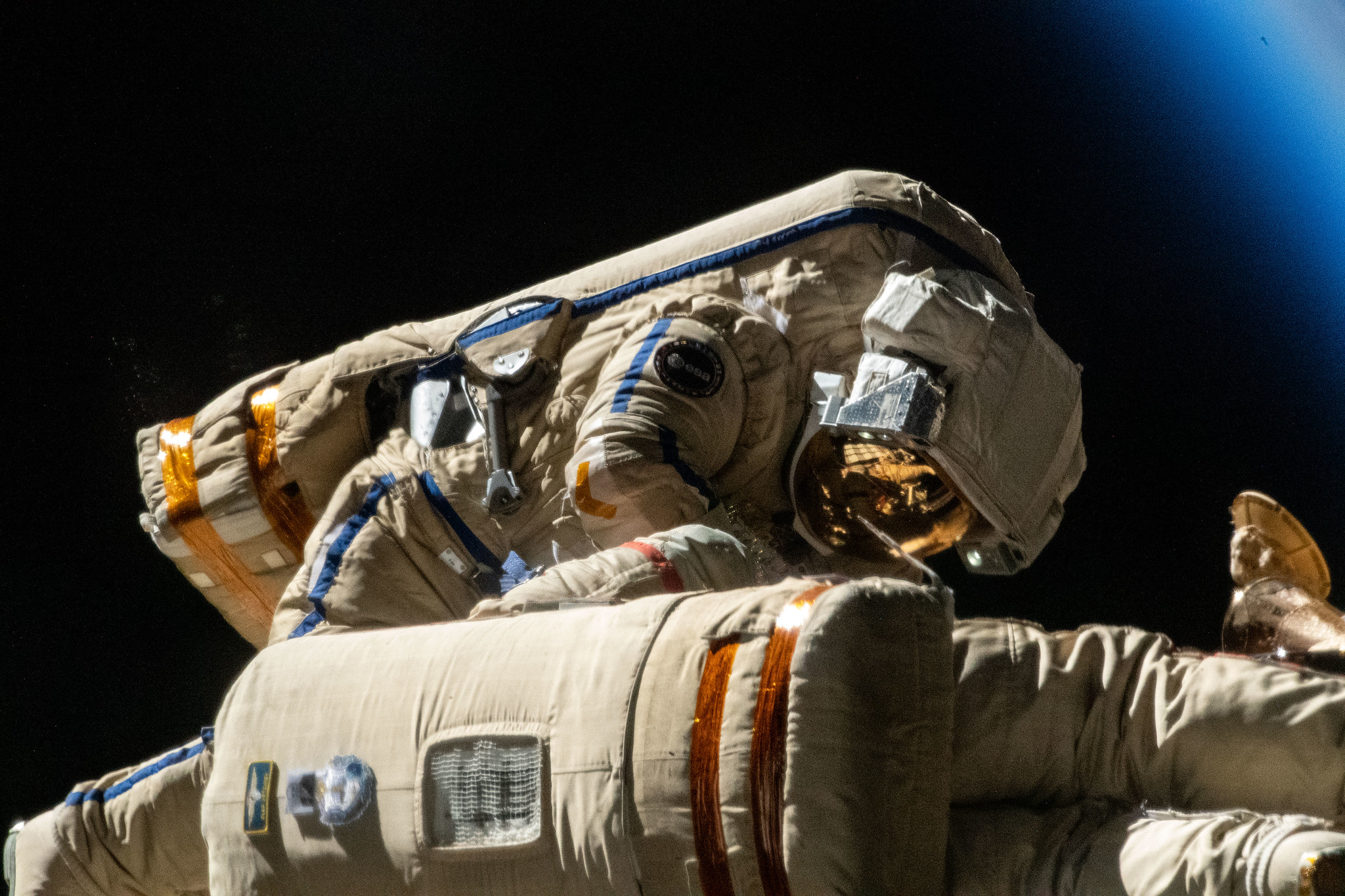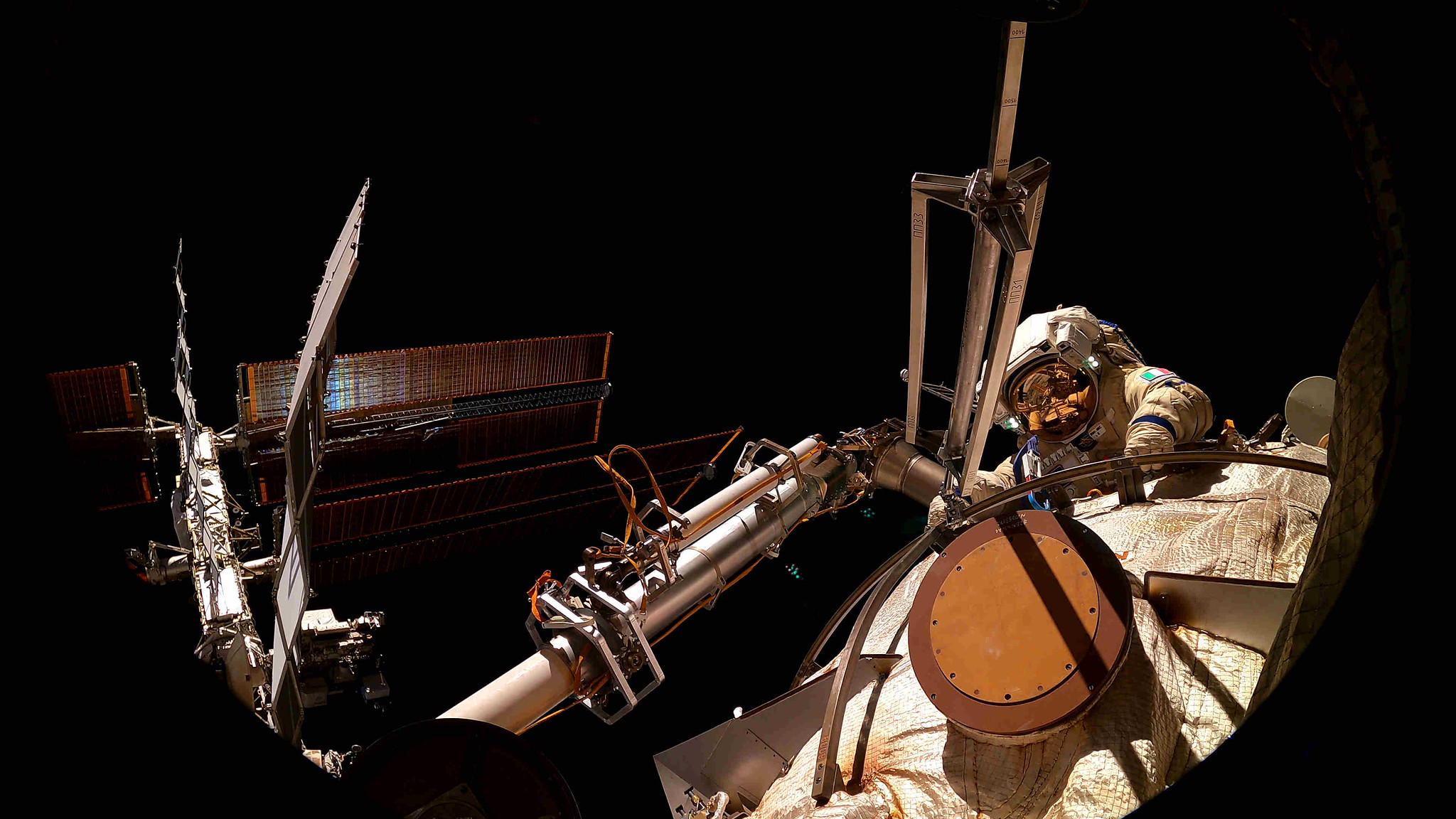In photos: Astronaut Samantha Cristoforetti takes Europe's historic 1st female spacewalk
Enjoy the view from the first-ever European female spacewalker, who made her sortie on July 21.

European Space Agency astronaut Samantha Cristoforetti became the first European female spacewalker on July 21, when she completed a seven-hour spacewalk outside of the International Space Station along with Russian cosmonaut Oleg Artemyev.
The event was also the first time in nearly 25 years that any European participated in a Russian-operated spacewalk. The duo spent 7 hours and 5 minutes configuring a new robotic arm for the Russian segment of the space station, and deploying several small satellites.
You can see more of Cristoforetti's space adventures in this slideshow.
Read more: Spacewalkers configure new space station robotic arm on rare Russian-European EVA

Cristoforetti, shown here with fellow European Space Agency astronaut Alexander Gerst during training, used the Russian-made Orlan spacesuit during her July 21 excursion. Unlike NASA's Extravehicular Mobility Unit spacesuit, Orlans are designed to be used in space with no return to the ground for servicing.
Typical disposal methods for old Orlans include putting them in Progress cargo spacecraft to naturally burn up in the atmosphere, or jettisoning the used gear overboard.

Orlan suits use two variants of stripes on the spacesuits, to distinguish spacewalkers from each other. The lead spacewalker, Russian cosmonaut Oleg Artemyev, is just visible to the right of the image above in red stripes. Cristoforetti, in center of the view, is shown with blue stripes.
Spacewalks are typically broadcast in real time to mission controllers in both Moscow and NASA, allowing ground support to assist the spacesuited crew by looking at exactly what the crew is looking at, in real time.

Since Cristoforetti was working in microgravity, this allowed her to orient her body in the way that was most convenient to reach the equipment on the outside of the Russian segment. All astronauts like Cristoforetti must train in ground facilities simulating the space station, including the Neutral Buoyancy Laboratory at NASA's Johnson Space Center in Houston.
The laboratory features a huge pool that has a set of modules similar to those of the ISS, allowing crews to practice the best handholds for their tasks and also to learn how to maneuver in microgravity. Each spacewalk's tasks is rehearsed to try to make sure that everything can be accomplished in time, as spacesuit resources in terms of water, oxygen and power are limited.

Cristoforetti (top) worked closely with Artemyev (bottom) on several spacewalk tasks. The duo mounted a temporary platform that will be used by the new European Robotic Arm (ERA). The arm was installed on an earlier spacewalk, but requires multiple excursions to configure.
The 37-foot-long (11-m) ERA will more equipment and scientific around the Russian segment of the space station. It's not the first ISS robotic arm; for example, the Canadian Canadarm2 robotic arm and the Japanese Kibo robotic arm are veterans in helping the space station's mandate of conducting research and performing maintenance.

Aside from working on the arm, Artemyev (left) and Cristoforetti put together a payload adapter for the Nauka module. This adapter is meant to be a support for tools and payloads for crews doing Russian-segment spacewalks in the future.
Another of the tasks saw Artemyev configure an external control panel, called the External Man Machine Interface. Eventually, that interface will let future spacewalkers manipulate the arm outside the space station. No other robotic arm on the station can be controlled from the outside, making the European Robotic Arm unique in this capability.

Working amid spectacular views of the Earth and of the space station, Cristoforetti and her Russian colleague also focused on releasing 10 nanosatellites by hand. These little machines formed a radio technology experiment and were named after Konstantin Tsiolkovsky, a Soviet-era rocket pioneer.
"I see the Earth and deploy in progress," Artemyev said while releasing the first of the satellites, through English-language interpretation provided by the spacewalk broadcast on NASA Television. "There it goes."

While ground teams did their best to schedule tasks that would fit in well with the projected seven-hour spacewalk timeline, the spacewalkers were delayed in exiting the hatch by about 40 minutes. Moscow therefore elected to postpone one of the major tasks to another time.
The crew was supposed to extend a Strela telescoping boom between the Zarya service module and the Poisk research module, a task that was meant to make future spacewalks easier. Ground control called off the task, however: "We are terminating because of the spacesuit life support system constraints," Russian mission control radioed to the spacewalkers.

The spacewalkers next closed out their tasks and made their way to the Poisk airlock, closing the hatch at 5:55 p.m. EDT (2155 GMT) and concluding the spacewalk. It was the sixth career spacewalk for Artemyev and also marked the sixth ISS spacewalk overall for 2022 so far.
Overall, the ISS has had 251 spacewalks supporting the assembly, upgrade and maintenance of the orbiting facility since 1998. While Cristoforetti was the first European to don an Orlan at the ISS, three ESA astronauts have done so before at the former Soviet-Russian Mir space station: Jean-Loup Chrétien, Thomas Reiter and Jean-Pierre Haigneré.

Cristoforetti, seen here beaming in her Orlan spacesuit cooling garment, conveyed her thanks to all the support teams in a Twitter message on July 28, 2022.
"Just two words: THANK YOU! Thank you all in Europe, Moscow, Houston and @Space_Station," she wrote. "Thanks for working to make this possible, thanks for the training, the planning, the real-time support, the videos and pictures, the trust and the encouragement. It was a dream come true."

Elizabeth Howell (she/her), Ph.D., was a staff writer in the spaceflight channel between 2022 and 2024 specializing in Canadian space news. She was contributing writer for Space.com for 10 years from 2012 to 2024. Elizabeth's reporting includes multiple exclusives with the White House, leading world coverage about a lost-and-found space tomato on the International Space Station, witnessing five human spaceflight launches on two continents, flying parabolic, working inside a spacesuit, and participating in a simulated Mars mission. Her latest book, "Why Am I Taller?" (ECW Press, 2022) is co-written with astronaut Dave Williams.
